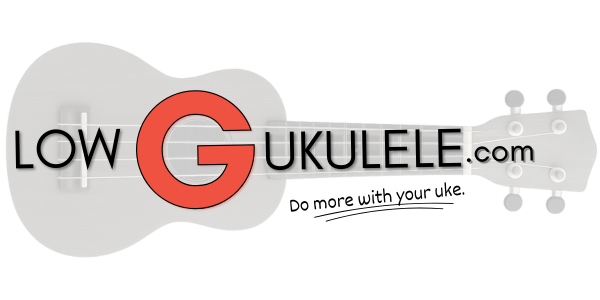Last week, I presented an overview of the CAGED system for ukulele. With CAGED, you can find alternate voicings of ukulele chords up the neck by memorizing a few shapes and knowing where to find root notes. But what if you want a chord other than a simple major chord? What if you want a sus4 chord or something really obscure, like a Cmaj6(b5)?
Technically, you could build CAGED-style shapes for every chord type and memorize them, but that isn’t practical (or sane). You could also buy a chord dictionary and flip through page after page of diagrams until you find what you’re looking for, but a chord dictionary with literally every voicing of every chord wouldn’t be something you could carry around with you easily.
The simplest solution to finding particular ukulele chords and all of their possible variations is to use a chord finder tool, and boy, do I have a great one to share with you today:
LowG.net Ukulele Chord Finder Tool
LowG.net is a new website put together by ukulele enthusiast Teppo Salonen. With Teppo’s chord finder tool, you can build any type of chord you can imagine, complete with complicated, jazzy extensions, and get a series of diagrams like this:

At the top of each chord chart, you’ll find a full neck diagram showing the locations of all of the notes in the chord type you’ve selected. Below, every practical combination of those notes is laid out. You can even hear each chord, strummed or as an arpeggio, by clicking on it.
The only thing that might confuse you (even though it’s 100% correct) is the use of slash chord naming conventions for every chord, even for the familiar open position shapes.
What are slash chords?
You may have noticed that many of the chords in the diagrams on LowG.net (even some familiar ones) include slashes and extra letters:

That’s just a regular C chord, right? So why does is say “C/G”? (Note that you only see this notation for this particular chord if you turn on low G tuning as an option at the top of the page.) When you see a slash and an extra letter on a chord diagram, it is telling you that the lowest note of the chord voicing isn’t the root note.
In the example above, because I have it set to low G tuning, the lowest note of the chord is the open G string. If you turn off low G tuning, the lowest note of the chord is the open C string, and the slash disappears. This same thing happens on other common open chord shapes. Here’s a couple of examples:
- A standard D chord is listed as D/A in low G tuning.
- A standard F chord is listed as F/C in standard tuning and F/A in low G.
Ultimately, this is just another layer of useful information. A C chord with a G in the bass does sound different than a C chord with a C in the bass:

You’re more likely, especially if you’re a beginner, to play the standard open chord, but if you are ever writing a song or an arrangement and want to be able to create a particular sound, this kind of information is critical.
If you’re looking for an easy-to-use, comprehensive chord finder, you cannot go wrong with LowG.net.

Leave a Reply